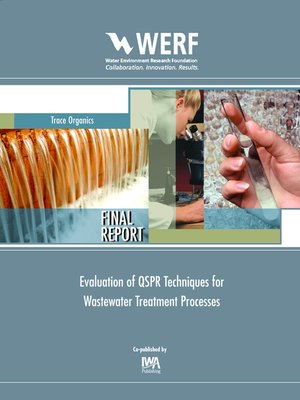Evaluation of QSPR Techniques for Wastewater Treatment Processes
ebook ∣ WERF Research Report
By Eric Dickenson

Sign up to save your library
With an OverDrive account, you can save your favorite libraries for at-a-glance information about availability. Find out more about OverDrive accounts.
Find this title in Libby, the library reading app by OverDrive.



Search for a digital library with this title
Title found at these libraries:
| Library Name | Distance |
|---|---|
| Loading... |
Most households regularly use products containing trace organic compounds (TOrC), including endocrine disrupting compounds (EDCs) pharmaceutically active compounds (PhACs), personal care products (PCPs), and household chemicals (HHCs), which ultimately end up in municipal wastewater treatment systems. These emerging TOrC are of concern due to the increasing number of reports of reproductive disorders in aquatic wildlife residing below wastewater outfalls and the continuous creation of new synthetic TOrCs, which precludes comprehensive testing for all potentially toxic compounds.
In order to assess the exposure of these compounds into the environment there is a need to evaluate their removal within conventional wastewater treatment systems. The near impossibility of experimentally studying the fate and transport of current and future emerging contaminants on an individual basis indicates a need to develop a tool which quickly provides guidance on how effectively certain compounds are removed during wastewater treatment. This tool would provide utilities the ability to quickly screen an organic compound of concern and provide a meaningful response in regards to exposure assessment. Quantitative structure property relationships (QSPRs) are useful and powerful tools for quickly screening the environmental fate of emerging contaminants and assessing their removal within treatment systems. However, an evaluation of existing QSPR models applicable for wastewater removal mechanisms is lacking.
The objective of this study was to evaluate existing QSPRs for predicting the partitioning of a TOrC between the aqueous and solids phases during primary and activated sludge treatments and the transformation rates of a TOrC during biological activated-sludge and chlorine oxidation treatments.







